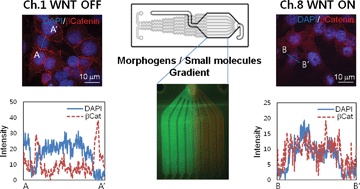Diffusion- and convection-based activation of Wnt/β-catenin signaling in a gradient generating microfluidic chip†
Abstract
Stem cells and developing tissues respond to long-range signaling molecules (morphogens), by starting different nuclear programs that decide about the cell fate. Cells sense the local morphogen concentration and the shape of the gradient. We developed a two-chambered microfluidic chip to reproduce the in vivo situation under shear stress free conditions. The gradient is generated in the lower part of our device and recognized by cells grown in the upper part in the microchamber. We tested our device by activating the Wnt/β-catenin signaling pathway in HeLa cells as proven by nuclear β-catenin accumulation in response to the Wnt pathway activator 6-bromoindirubin-3′-oxime (BIO). Applying the same readout system to a recombinant Wnt3a and Dkk-1 bipolar gradient we demonstrate that our microfluidic chip is suitable for morphogens as well as small molecules. More interestingly, our microfluidic device is highly flexible. While the generated gradients are stable for several hours and reproducible, we can change the kind and the shape of the gradient actively on demand. We also can switch from diffusion- to convection-based transport, thus applying the morphogen gradient either in a polarized or non-polarized manner.


 Please wait while we load your content...
Please wait while we load your content...